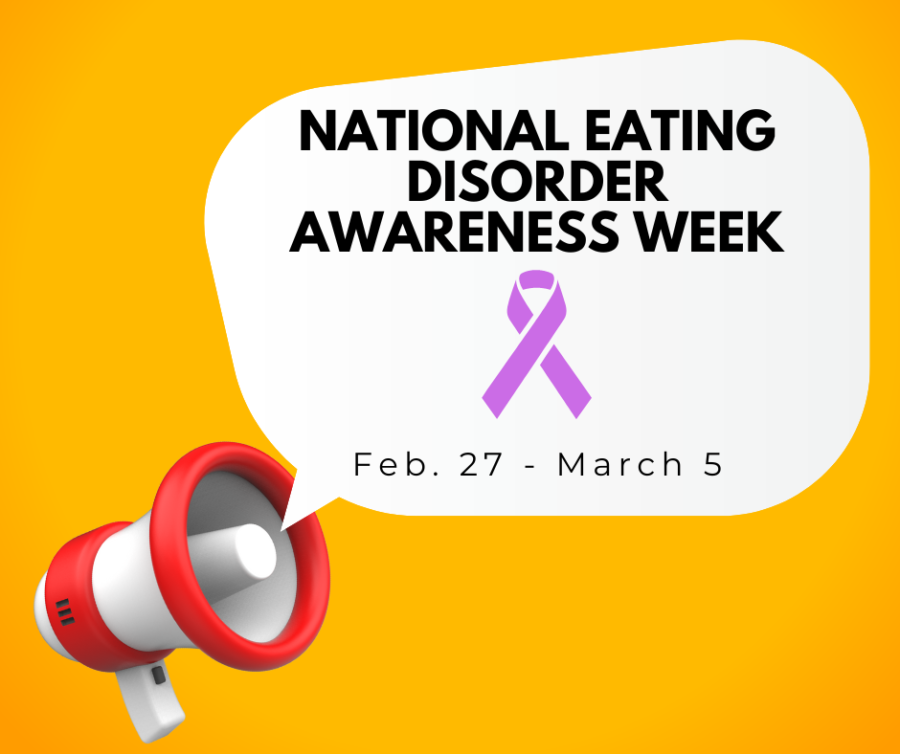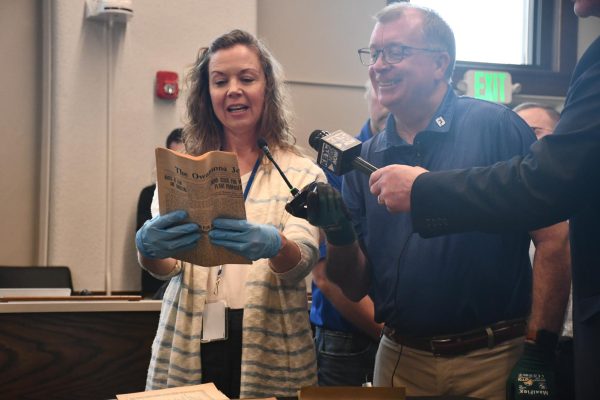Spreading eating disorder awareness this week and every week
The lilac ribbon is an international symbol for eating disorder awareness.
March 3, 2023
Feb. 27 through March 5 is National Eating Disorder Awareness Week. According to the National Association of Anorexia Nervosa and Associated Disorders, 28.8 million Americans will struggle with an eating disorder within their lifetime. Eating disorders are not exclusive to certain body types, races, ages, sexual orientations or gender identities.
Ms. Halley Ritscher teaches the College Psychology course at OHS through Minnesota State University, Mankato. The course teaches a psychological view of a wide variety of topics, including eating disorders and their impact.
Ritscher said, “Eating disorders are super prevalent among this population and being able to recognize signs of them in yourself or others is important so everyone can get the help they need.”
Eating disorders are deadly, and unfortunately, relatively common. Every year, it is estimated that 10,200 people will die as a direct result of an eating disorder. These disorders are surrounded by stereotypes that are harmful to those who are experiencing them or have experienced them. Eating disorders are anything but discriminatory, and are the second deadliest mental illness following opioid addiction.
A misconception shown in the media is that eating disorders are exclusively an issue among women; however, a statistic that is often overlooked is that one in three people struggling with eating disorders is male. Due to stigma and cultural influences, men are less likely to seek help since it is stereotypically characterized as feminine. Stereotypes are not only limited to gender. It is widely perceived that eating disorders are primarily frequent in individuals who are underweight. Despite this idea, less than six percent of individuals experiencing disordered eating are medically diagnosed as underweight.
Horribly, there is a stigma surrounding eating disorders that they are a choice. Eating disorders are biopsychosocial issues. Meaning that they can be developed in a variety of ways, and the individual has no choice in whether or not one develops. Biopsychosocial disorders come from biology, genetics, psychological health and environmental factors. According to Mayo Clinic, the risk factors of eating disorders can come from family history, various mental health disorders, dieting and stress. Biological factors can be caused by a change in brain chemicals. Implementing the idea that eating disorders are a choice thoroughly invalidates the life threatening experience that one individual will die from every 52 minutes.
WHAT EVERYONE SHOULD KNOW ABOUT EATING DISORDERS
Although eating disorders are among the most deadly mental illnesses, there is little awareness surrounding them and little education taught about them.
Anonymous sophomore girl said, “It can be hard to reach out because of the guilt or shame you feel. Sometimes I felt like my emotions were stupid and I was being dramatic.”
The Diagnostic and Statistical Manual of Mental Disorders, 5th edition (DSM-5) recognizes eight different eating disorders. There are six types that are specified: Pica, Rumination Disorder (RD), Avoidant/Restrictive Food Intake Disorder (ARFID), Anorexia Nervosa (AN), Bulimia Nervosa (BN) and Binge Eating Disorder (BED). The two besides these, are recognized as “umbrella” diagnoses: Other Specified Feeding or Eating Disorder (OSFED) and Unspecified Feeding or Eating Disorder (UFED).
An article by Eating Disorder Hope writes that recent statistics have shown that Binge Eating Disorder (BED) is the most common among all eight types. Binge Eating Disorder has more depth than occasionally overeating. A binge eating episode is when an individual consumes a broad amount of food in a small amount of time. Although these episodes characterize the disorder, there is more complexity to it. If Binge Eating Disorder goes untreated, it can be life threatening.
Anorexia Nervosa (AN) has the highest mortality rate of the eight disorders listed above. Anorexia Nervosa affects people by giving them a distorted view of their bodies, they view themselves as overweight despite the possibility that they are drastically underweight. People struggling with this disorder fear weight gain and limit their food intake. Anorexia Nervosa damages the cardiovascular system, the gastrointestinal system and neurohormone production. The disorder also takes a detrimental toll on the brain, including: insufficient calories, altered brain structure, lessened cognitive function and the occurrence of other mental health disorders.
Anonymous junior girl said, “If I think back to a year and a half ago I thought I was going to have to live like that forever. But going to treatment made me realize there was hope and I had a chance at life.”
While being in an athletic activity has its positive effects on mental health, athletes are more likely to become clinically diagnosed with an eating disorder than those who are not athletes. Sadly, many sports emphasize appearance and advertise an “ideal” body. Data from the National Association of Anorexia Nervosa and Associated Disorders discloses that athletes are less likely to seek professional help due to the stigma surrounding their sport and eating disorders.
The aforementioned sophomore girl said, “I struggled because I would have to look in a mirror everyday at dance practice and compare myself to others in the class. How you look was a huge thing and I would feel guilty with every unhealthy snack or indulgence.”
Eating Disorder Awareness Week is an opportunity for people to voice their experience and for those who are uneducated to become informed about eating disorders. An article by Seeds of Hope lists a few ways that everyone can be helpful towards those who are struggling, even if the person that is struggling is themselves. Avoiding comments on appearance, promoting body positivity, sharing personal stories, checking in with friends and family and becoming educated; these are just a few examples of how everyone can participate in eating disorder awareness.
Aforementioned junior girl said, “I don’t think people understand how their words and things they post harm others. None of our bodies were made to look the exact same but there are toxic ideals surrounding what we should look like. But all of our bodies were made differently.”
Places in Minnesota that offer eating disorder help are The Emily Program, The Joy Project for Eating Disorders and Rogers Behavioral Health. Signs and symptoms to watch out for in one’s self or in a loved one include dramatic weight gain or weight loss, rapid decrease or increase in food consumption, excessive exercise, a loss of control with food, medical complications and many more. Contact NEDA for eating disorder recovery resources. Contact can be achieved through call or text with the number (800) 931-2237 or through online chat.






